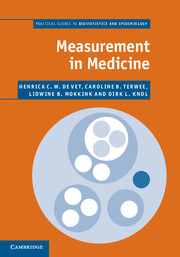Book contents
- Frontmatter
- Contents
- Preface
- 1 Introduction
- 2 Concepts, theories and models, and types of measurements
- 3 Development of a measurement instrument
- 4 Field-testing: item reduction and data structure
- 5 Reliability
- 6 Validity
- 7 Responsiveness
- 8 Interpretability
- 9 Systematic reviews of measurement properties
- References
- Index
1 - Introduction
Published online by Cambridge University Press: 07 September 2011
- Frontmatter
- Contents
- Preface
- 1 Introduction
- 2 Concepts, theories and models, and types of measurements
- 3 Development of a measurement instrument
- 4 Field-testing: item reduction and data structure
- 5 Reliability
- 6 Validity
- 7 Responsiveness
- 8 Interpretability
- 9 Systematic reviews of measurement properties
- References
- Index
Summary
Why this textbook on measurement in medicine?
Measurements are central to clinical practice and medical and health research. They form the basis of diagnosis, prognosis and evaluation of the results of medical interventions. Advances in diagnosis and care that were made possible, for example, by the widespread use of the Apgar scale and various imaging techniques, show the power of well-designed, appropriate measures. The key words here are ‘well-designed’ and ‘appropriate’. A decision-maker must know that the measure used is adequate for its purpose, how it compares with similar measures and how to interpret the results it produces.
For every patient or population group, there are numerous instruments that can be used to measure clinical condition or health status, and new ones are still being developed. However, in the abundance of available instruments, many have been poorly or insufficiently validated. This book primarily serves as a guide to evaluate properties of existing measurement instruments in medicine, enabling researchers and clinicians to avoid using poorly validated ones or alerting them to the need for further validation.
- Type
- Chapter
- Information
- Measurement in MedicineA Practical Guide, pp. 1 - 6Publisher: Cambridge University PressPrint publication year: 2011
- 4
- Cited by



